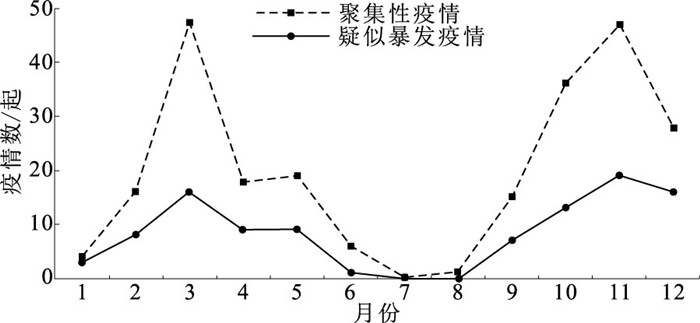Epidemic characteristics and spatial distribution of vomiting and diarrhea outbreaks in schools and kindergartens in Shanghai from 2015 to 2019
-
摘要:
目的 回顾性分析2015—2019年上海市学校和托幼机构呕吐腹泻疫情的流行特征和空间分布,为优化学校和托幼机构呕吐腹泻疫情防控提供科学依据。 方法 分析比较2015—2019年上海市疾病预防控制中心接报呕吐腹泻疫情的流行病学特征,计算学校和托幼机构疫情发生率、发病率,并采用多因素Logistic回归分析其影响因素;采用Moran's I指数分析全局和局部空间自相关性。 结果 接报的344起呕吐腹泻疫情中,98.26%发生在幼儿园、中小学等各类教育机构,单起疫情涉及病例中位数为15例。疑似暴发疫情数和涉及病例数构成比在2015年最高(60.00%,84.35%),随后逐年下降至2019年的16.00%和38.80%。86.98%的疫情传播途径为人-人接触传播;在采集的329起疫情病例和/或环境样本中,检出的最主要病原为诺如病毒(280起),2016年首次在疫情中检出札如病毒。疫情有明显的季节性,包括2个高峰(11,3月)和1个低谷(7月);主要发生在小学(44.38%)和幼儿园(32.84%),与幼儿园相比,小学、一贯制学校、中学和其他机构发生疑似暴发疫情的概率更高(调整OR值分别为6.40,9.16,12.64,5.58,P值均 < 0.01)。未发现各区教育机构疫情发生率、发病率存在高-高聚集区域。 结论 小学和幼儿园是呕吐腹泻疫情的防控重点场所,每学期开学及每年流行高峰前,应针对性加强防控措施;疑似病例出现症状后及时报告、暂缓入校,规范机构内呕吐物处置,以减少人际传播、控制疫情规模。 Abstract:Objective To retrospectively analyze the epidemic characteristics and spatial distribution of vomiting and diarrhea outbreaks in schools and kindergartens in Shanghai from 2015 to 2019, so as to provide the scientific evidence for optimizing prevention and control of vomiting and diarrhea outbreaks in schools and kindergartens. Methods Data collection and analysis were carried out on the vomiting and diarrhea outbreaks reported to Shanghai Municipal Center for Disease Control and Prevention from 2015 to 2019. Epidemiological characteristics were analyzed and compared. The proportion and incidence of outbreaks in schools and kindergartens were calculated, and the influencing factors of outbreaks were analyzed by multivariate Logistic regression. The index of Moran's I was used for the global and local spatial auto-correlation analysis. Results Among the 344 vomiting and diarrhea outbreaks, 98.26% occurred in kindergartens, primary schools, middle schools and other educational institutions. The median number of cases per outbreak was 15. The number of suspected outbreaks and the percentage of cases involved peaked in 2015 (60.00%, 84.35%) and then decreased year by year to 16.00% and 38.80% in 2019. About 86.98% of the outbreaks were transmitted by human-to-human contact. Among the 329 outbreaks with samples collected from cases and/or environments, the main pathogen detected was norovirus (n=280), and sapovirus was detected in outbreak for the first time in 2016. The outbreaks showed obvious seasonality, with two peaks (November, March) and one trough (July), and the majority of outbreaks occurred in primary schools (44.38%) and kindergartens (32.84%). Compared with kindergartens, the probabilities of suspected epidemic outbreaks in primary schools, combined schools, middle schools and other educational institutions were higher (adjusted OR=6.40, 9.16, 12.64, 5.58, P < 0.01). The proportion and incidence of outbreaks in educational institutions in different districts showed no high-high aggregation areas. Conclusions Primary schools and kindergartens are key places for the prevention and control of vomiting and diarrhea outbreaks. Targeted prevention and control measures should be strengthened at the beginning of each semester and before the peak of the epidemic each year. Timely reporting of symptoms, suspension of school admissions after symptoms appear and standardized disposal of vomit are effective measures to reduce interpersonal transmission and control the scale of an outbreak. -
Key words:
- Vomiting /
- Diarrhea /
- Disease outbreaks /
- Incidence /
- Epidemiologic studies
1) 利益冲突声明 所有作者声明无利益冲突。2) 宫霄欢和肖文佳为共同第一作者。 -
表 1 上海市2015—2019年学校和托幼机构呕吐腹泻疫情病例分布
Table 1. Distribution of cases of vomiting and diarrhea outbreaks in schools and kindergartens from 2015 to 2019 in Shanghai
机构类型 疫情数 涉及病例数 总疫情 聚集性疫情 疑似暴发疫情 总疫情 聚集性疫情 疑似暴发疫情 小学 150 97(64.67) 53(35.33) 3 136 1 194(38.07) 1 942(61.93) 幼儿园 111 99(89.19) 12(10.81) 1 546 1 139(73.67) 407(26.33) 一贯制学校 34 20(58.82) 14(41.18) 720 271(37.64) 449(62.36) 中学 29 15(51.72) 14(48.28) 783 221(28.22) 562(71.78) 其他* 14 6(42.86) 8(57.14) 497 94(18.91) 403(81.09) 合计 338 237(70.12) 101(29.88) 6 682 2 919(43.68) 3 763(56.32) 注:疫情数和涉及病例数()内数字为构成比/%;*包括中专、高校、早教中心。 表 2 上海市2015—2019年学校和托幼机构呕吐腹泻疫情病原学特征构成
Table 2. Etiological characteristics of vomiting and diarrhea outbreaks in schools and kindergartens from 2015 to 2019 in Shanghai
病原 选项 检出病原疫情 仅检出该种病原疫情 同时检出其他病原疫情 病毒 诺如病毒 280 259(92.50) 21(7.50) 札如病毒 23 19(82.61) 4(17.39) 轮状病毒 4 0 4(100.00) 肠道腺病毒 2 1(50.00) 1(50.00) 细菌 金黄色葡萄球菌 11 1(9.09) 10(90.91) 大肠埃希菌 4 0 4(100.00) 蜡样芽胞杆菌 2 0 2(100.00) 沙门菌 2 0 2(100.00) 注: ()内数字为构成比/%。 表 3 上海市2015—2019年学校和托幼机构呕吐腹泻疫情影响因素的Logistic回归分析(n=338)
Table 3. Logistic regression analysis of influencing factors of vomiting and diarrhea outbreaks in schools and kindergartens from 2015 to 2019 in Shanghai(n=338)
截距与自变量 选项 参照组 β值 P值 调整OR值(95%CI) 截距 -2.40 < 0.01 地区 郊区 城区 0.30 0.31 1.35(0.76~2.43) 年份 2015 2019 1.93 < 0.01 6.90(2.17~23.62) 2016 1.50 < 0.01 4.46(1.53~13.35) 2017 1.09 0.01 2.97(1.33~7.03) 2018 0.58 0.17 1.79(0.79~4.22) 季节 秋季 冬季 -0.03 0.93 0.97(0.47~2.02) 春季 -0.43 0.22 0.65(0.33~1.29) 夏季 -0.88 0.44 0.42(0.02~2.89) 机构类型 其他* 幼儿园 1.72 < 0.01 5.58(2.74~12.26) 小学 1.86 < 0.01 6.40(2.46~17.22) 一贯制学校 2.21 < 0.01 9.16(3.35~26.08) 中学 2.54 < 0.01 12.64(3.53~48.39) 病原学情况 检出病毒 未检出病毒 -0.81 0.08 0.44(0.18~1.11) 注: *包括中专、高校、早教中心。 -
[1] GBD 2019 Diseases and Injuries Collaborators. Global burden of 369 diseases and injuries in 204 countries and territories, 1990-2019: a systematic analysis for the global burden of disease study 2019[J]. Lancet, 2020, 396(10258): 1204-1222. doi: 10.1016/S0140-6736(20)30925-9 [2] 连怡遥, 骆洪梅, 冉陆, 等. 中国2014—2018年学校和托幼机构诺如病毒疫情流行病学分析[J]. 中国学校卫生, 2019, 40(3): 406-410. doi: 10.16835/j.cnki.1000-9817.2019.03.025LIAN Y Y, LUO H M, RAN L, et al. Epidemiologic characteristics of norovirus outbreak in schools and kindergardens in China during 2014-2018[J]. Chin J Sch Health, 2019, 40(3): 406-410. (in Chinese) doi: 10.16835/j.cnki.1000-9817.2019.03.025 [3] JIN M, WU S, KONG X, et al. Norovirus outbreak surveillance, China, 2016-2018[J]. Emerg Infect Dis, 2020, 26(3): 437-445. doi: 10.3201/eid2603.191183 [4] 黎健, 潘浩, 肖文佳, 等. 上海市2010—2014年确认和疑似诺如病毒感染聚集性疫情流行病学分析[J]. 中华流行病学杂志, 2015, 36(11): 1249-1252. doi: 10.3760/cma.j.issn.0254-6450.2015.11.013LI J, PAN H, XIAO W J, et al. Epidemiology of confirmed and suspected norovirus outbreaks in Shanghai, 2010-2014[J]. Chin J Epidemiol, 2015, 36(11): 1249-1252. (in Chinese) doi: 10.3760/cma.j.issn.0254-6450.2015.11.013 [5] 谢迪, 何莲花, 刘晖, 等. 人诺如病毒感染引起的急性胃肠炎流行特征及其影响因素的研究进展[J]. 病毒学报, 2024, 40(1): 140-150.XIE D, HE L H, LIU H, et al. Research advances in the epidemic characteristics and influencing factors of human norovirus infection-induced acute gastroenteritis[J]. Chin J Virol, 2024, 40(1): 140-150. (in Chinese) [6] 上海市卫生和计划生育委员会. 关于做好2014年夏秋季传染病防控工作的通知(沪卫计疾控[2014]13号附件2)[Z]. 2014.Shanghai Municipal Health and Family Planning Commission. Notice on the prevention and control of infectious diseases in the summer and autumn of 2014 (Shanghai Weiji Disease Control[2014] No. 13 Annexe 2)[Z]. 2014. (in Chinese) [7] 史进梅, 赵俊琴, 李建国. 空间自相关方法及其在公共卫生领域的应用[J]. 中华劳动卫生职业病杂志, 2020, 38(5): 395-400. doi: 10.3760/cma.j.cn121094-20190507-00183SHI J M, ZHAO J Q, LI J G, et al. Spatial autocorrelation and its application in public health field[J]. Chin Ind Hyg Occup Dis, 2020, 38(5): 395-400. (in Chinese) doi: 10.3760/cma.j.cn121094-20190507-00183 [8] MATTISON C P, CALDERWOOD L E, MARSH Z A, et al. Childcare and school acute gastroenteritis outbreaks: 2009-2020[J]. Pediatrics, 2022, 150(5): e2021056002. doi: 10.1542/peds.2021-056002 [9] PARRÓN I, BARRABEIG I, SOLDEVILA N, et al. Outbreaks of gastroenteritis due to norovirus in schools and summer camps in Catalonia, 2017-2019[J]. Microbiol Spectr, 2022, 10(3): e0011922. doi: 10.1128/spectrum.00119-22 [10] 华伟玉, 邢彦, 刘锋, 等. 2014—2018年北京市海淀区诺如病毒聚集性疫情流行特征与病原学研究[J]. 中国病毒病杂志, 2020, 10(2): 142-146.HUA W Y, XING Y, LIU F, et al. Epidemiologic characteristics and etiology of norovirus aggregation in Haidian District of Beijing from 2014 to 2018[J]. Chin J Viral Dis, 2020, 10(2): 142-146. (in Chinese) [11] 苏通, 刘莹莹, 赵文娜, 等. 河北省2015―2020年其他感染性腹泻流行特征及时空聚集性[J]. 中华疾病控制杂志, 2022, 26(2): 175-181.SU T, LIU Y Y, ZHAO W N, et al. Epidemiological characteristics and spatial-temporal cluster analysis of other infectious diarrhea in Hebei Province from 2015 to 2020[J]. Chin J Dis Control Prev, 2022, 26(2): 175-181. (in Chinese) [12] 刘云广, 黄茜, 张乐, 等. 2004—2018年中国流行性感冒发病率的时空分析及其预测模型研究[J]. 中华疾病控制杂志, 2023, 27(2): 176-183.LIU Y G, HUANG Q, ZHANG L, et al. Spatial-temporal analysis and prediction model for the incidence of influenza from 2004 to 2018 in China[J]. Chin J Dis Control Prev, 2023, 27(2): 176-183. (in Chinese) [13] 查玉娥, 陈国良, 姚伟. 河南和四川省2016-2018年农村学校环境卫生与学生个人卫生变化[J]. 中国学校卫生, 2021, 42(10): 1582-1585. doi: 10.16835/j.cnki.1000-9817.2021.10.034ZHA Y E, CHEN G L, YAO W. Changes of environmental and personal hygiene in rural schools of Henan and Sichuan from 2016 to 2018[J]. Chin J Sch Health, 2021, 42(10): 1582-1585. (in Chinese) doi: 10.16835/j.cnki.1000-9817.2021.10.034 [14] 戴映雪, 徐凯, 冯松颀, 等. 成都市学校诺如病毒感染疫情与厕所设计及卫生的关联[J]. 中国学校卫生, 2023, 44(6): 938-941. doi: 10.16835/j.cnki.1000-9817.2023.06.032DAI Y X, XU K, FENG S Q, et al. Association between norovirus epidemics and school toilets design and management in Chengdu City[J]. Chin J Sch Health, 2023, 44(6): 938-941. (in Chinese) doi: 10.16835/j.cnki.1000-9817.2023.06.032 [15] 中华人民共和国卫生部. 中小学校传染病预防控制工作管理规范: GB 28932—2012[S]. 北京, 2012.Ministry of Health of the PRC. Regulation of infectious diseases prevention and control in primary and secondary schools: GB 28932-2012[S]. Beijing, 2012. (in Chinese) [16] 上海市市场监督管理局. 托幼机构消毒卫生规范: DB 31/T 8—2020[S]. 2020-09-01.Shanghai Municipal Administration for Market Regulation. Hygienic standards for disinfection of nursery and kindergarten: DB 31/T 8-2020[S]. 2020-09-01. (in Chinese) [17] 上海市市场监督管理局. 学校饮水卫生管理要求: DB 31/T 1361—2022[S]. 2022-12-01.Shanghai Municipal Administration for Market Regulation. Hygienic management requirements for drinking water in schools: DB 31/T 1361-2022[S]. 2022-12-01. (in Chinese) [18] 孙力菁, 罗春燕, 张喆, 等. 上海市中小学校卫生保健机构设置情况和人员能力提升需求[J]. 中国学校卫生, 2022, 43(6): 937-940. doi: 10.16835/j.cnki.1000-9817.2022.06.033SUN L J, LUO C Y, ZHANG Z, et al. Investigation on the establishment of health care institutions and the need for personnel capacity improvement in primary and secondary schools in Shanghai[J]. Chin J Sch Health, 2022, 43(6): 937-940. (in Chinese) doi: 10.16835/j.cnki.1000-9817.2022.06.033 [19] 张妍, 蒋泓. 上海市部分辖区4~6岁儿童家长的养育健康素养现况[J]. 上海预防医学, 2018, 30(11): 918-923.ZHANG Y, JIANG H. Parental health literacy of 4-6 years old children in some districts of Shanghai[J]. Shanghai J Prev Med, 2018, 30(11): 918-923. (in Chinese) -







 下载:
下载:


